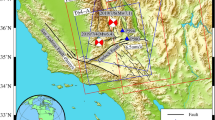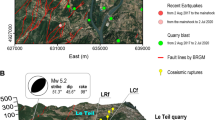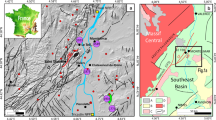Abstract
The San Andreas fault in California is a mature continental transform fault that accommodates a significant fraction of motion between the North American and Pacific plates. The two most recent great earthquakes on this fault ruptured its northern and central sections in 1906 and 1857, respectively. The southern section of the fault, however, has not produced a great earthquake in historic times (for at least 250 years). Assuming the average slip rate of a few centimetres per year, typical of the rest of the San Andreas fault, the minimum amount of slip deficit accrued on the southern section is of the order of 7–10 metres, comparable to the maximum co-seismic offset ever documented on the fault1,2. Here I present high-resolution measurements of interseismic deformation across the southern San Andreas fault system using a well-populated catalogue of space-borne synthetic aperture radar data. The data reveal a nearly equal partitioning of deformation between the southern San Andreas and San Jacinto faults, with a pronounced asymmetry in strain accumulation with respect to the geologically mapped fault traces. The observed strain rates confirm that the southern section of the San Andreas fault may be approaching the end of the interseismic phase of the earthquake cycle.
This is a preview of subscription content, access via your institution
Access options
Subscribe to this journal
Receive 51 print issues and online access
$199.00 per year
only $3.90 per issue
Buy this article
- Purchase on Springer Link
- Instant access to full article PDF
Prices may be subject to local taxes which are calculated during checkout


Similar content being viewed by others
References
Sieh, K., Stuiver, M. & Brillinger, D. A more precise chronology of earthquakes produced by the San Andreas fault in Southern California. J. Geophys. Res. 94, 603–623 (1989)
Weldon, R. J., Fumal, T. E., Biasi, G. P. & Scharer, K. M. Geophysics—Past and future earthquakes on the San Andreas fault. Science 308, 966–967 (2005)
Turcotte, D. L. & Schubert, G. Geodynamics 2nd edn (Cambridge Univ. Press, New York, 2002)
Lyons, S. & Sandwell, D. Fault creep along the southern San Andreas from interferometric synthetic aperture radar, permanent scatterers, and stacking. J. Geophys. Res. 108, doi:10:1029/2002JB001831 (2003)
Thatcher, W. & Lisowski, M. Long-term seismic potential of the San Andreas fault southeast of San Francisco, California. J. Geophys. Res. 92, 4771–4784 (1987)
Bennett, R. A., Friedrich, A. M. & Furlong, K. P. Codependent histories of the San Andreas and San Jacinto fault zones from inversion of fault displacement rates. Geology 32, 961–964 (2004)
Working Group on California Earthquake Probabilities. Seismic hazards in southern California: Probable earthquakes, 1994–2024. Bull. Seismol. Soc. Am. 85, 379–439 (1995)
Johnson, H. O., Agnew, D. C. & Wyatt, F. K. Present-day crustal deformation in southern California. J. Geophys. Res. 99, 23951–23974 (1994)
Bennett, R. A., Rodi, W. & Reilinger, R. E. Global positioning system constraints on fault slip rates in southern California and northern Baja, Mexico. J. Geophys. Res. 101, 21943–21960 (1996)
van der Woerd, J. et al. Long-term slip rate of the southern San Andreas Fault, from 10Be-26Al surface exposure dating of an offset alluvial fan. J. Geophys. Res 111, B04407, doi:10.1029/2004JB003559 (2006)
Fialko, Y. Probing the mechanical properties of seismically active crust with space geodesy: Study of the co-seismic deformation due to the 1992 M w7.3 Landers (southern California) earthquake. J. Geophys. Res. 109, B03307, doi:10.1029/2003JB002756 (2004)
DeMets, C., Gordon, R. G., Argus, D. F. & Stein, S. Current plate motions. Geophys. J. Int. 101, 425–478 (1990)
Weldon, R. J. & Sieh, K. E. Holocene rate of slip and tentative recurrence interval for large earthquakes on the San Andreas fault, Cajon Pass, southern California. Geol. Soc. Am. Bull. 96, 793–812 (1985)
Lisowski, M., Savage, J. & Prescott, W. H. The velocity field along the San Andreas fault in central and southern California. J. Geophys. Res. 96, 8369–8389 (1991)
Le Pichon, X., Kreemer, C. & Chamot-Rooke, N. Asymmetry in elastic properties and the evolution of large continental strike-slip faults. J. Geophys. Res. 110, B03405, doi:10.1029/2004JB003343 (2005)
Li, V. C. & Rice, J. Crustal deformation in great California earthquake cycles. J. Geophys. Res. 92, 11533–11551 (1987)
Kenner, S. & Segall, P. Lower crustal structure in Northern California: Implications from strain rate variations following the 1906 San Francisco earthquake. J. Geophys. Res. 108, 2011, doi:10.1029/2001JB000189 (2003)
Fialko, Y., Simons, M. & Agnew, D. The complete (3-D) surface displacement field in the epicentral area of the 1999 M w7.1 Hector Mine earthquake, southern California, from space geodetic observations. Geophys. Res. Lett. 28, 3063–3066 (2001)
Fialko, Y., Sandwell, D., Simons, M. & Rosen, P. Three-dimensional deformation caused by the Bam, Iran, earthquake and the origin of shallow slip deficit. Nature 435, 295–299 (2005)
Prescott, W. H. & Yu, S. B. Geodetic measurement of horizontal deformation in the Northern San Francisco Bay region, California. J. Geophys. Res. 91, 7475–7484 (1986)
Freymueller, J. T., Murray, M. H., Segall, P. & Castillo, D. Kinematics of the Pacific North America plate boundary zone, northern California. J. Geophys. Res. 104, 7419–7441 (1999)
Fialko, Y. et al. Deformation on nearby faults induced by the 1999 Hector Mine earthquake. Science 297, 1858–1862 (2002)
Thatcher, W. Microplate versus continuum description of active tectonic deformation. J. Geophys. Res. 100, 3885–3894 (1983)
Ben-Zion, Y. & Andrews, D. J. Properties and implications of dynamic rupture along a material interface. Bull. Seismol. Soc. Am. 88, 1085–1094 (1998)
Hauksson, E. Crustal structure and seismicity distribution adjacent to the Pacific and North America plate boundary in southern California. J. Geophys. Res. 105, 13875–13903 (2000)
Yule, D. & Sieh, K. Complexities of the San Andreas fault near San Gorgonio Pass: Implications for large earthquakes. J. Geophys. Res. 108, doi:10.1029/2001JB000451 (2003)
Fialko, Y., Rivera, L. & Kanamori, H. Estimate of differential stress in the upper crust from variations in topography and strike along the San Andreas fault. Geophys. J. Int. 160, 527–532 (2005)
Richards-Dinger, K. & Shearer, P. Earthquake locations in southern California obtained using source specific station terms. J. Geophys. Res. 105, 10939–10960 (2000)
Waters, M. R. Late Holocene lacustrine chronology and archaeology of ancient lake Cahuilla, California. Quat. Res. 19, 373–387 (1983)
Murray, J. & Segall, P. Testing time-predictable earthquake recurrence by direct measurement of strain accumulation and release. Nature 419, 287–291 (2002)
Weldon, R. J., Scharer, K. M., Fumal, T. E. & Biasi, G. P. Wrightwood and the earthquake cycle: What a long recurrence record tells us about how faults work. GSA Today 14, 4–10 (2004)
Cisternas, M. et al. Predecessors of the giant 1960 Chile earthquake. Nature 437, 404–407 (2005)
Sharp, R. V. San Jacinto fault zone in the Peninsular Ranges of southern California. Geol. Soc. Am. Bull. 78, 705–730 (1967)
Acknowledgements
I thank R. Weldon and P. Segall for suggestions. This work was supported by the NSF and the Southern California Earthquake Center (SCEC). Original InSAR data are copyright of the European Space Agency, distributed by Eurimage, Italy, and acquired via the WInSAR Consortium. The ERS SAR imagery was processed using the JPL/Caltech software package ROI_PAC. The continuous GPS data were provided by the Scripps Orbit and Permanent Array Center (SOPAC), and the campaign GPS and EDM data were provided by the Crustal Motion Model v3 of SCEC.
Author information
Authors and Affiliations
Corresponding author
Ethics declarations
Competing interests
Reprints and permissions information is available at npg.nature.com/reprintsandpermissions. The author declares no competing financial interests.
Supplementary information
Supplementary Notes
This file contains the Supplementary Methods and Supplementary Figures. (PDF 4524 kb)
Rights and permissions
About this article
Cite this article
Fialko, Y. Interseismic strain accumulation and the earthquake potential on the southern San Andreas fault system. Nature 441, 968–971 (2006). https://doi.org/10.1038/nature04797
Received:
Accepted:
Issue Date:
DOI: https://doi.org/10.1038/nature04797
This article is cited by
-
Feedback between megathrust earthquake cycle and plate convergence
Scientific Reports (2023)
-
Major southern San Andreas earthquakes modulated by lake-filling events
Nature (2023)
-
The overall-subshear and multi-segment rupture of the 2023 Mw7.8 Kahramanmaraş, Turkey earthquake in millennia supercycle
Communications Earth & Environment (2023)
-
Coseismic deformation and source characterisation of the 21 June 2022 Afghanistan earthquake using dual-pass DInSAR
Natural Hazards (2023)
-
Dynamic deformation and fault locking of the Xianshuihe Fault Zone, Southeastern Tibetan Plateau: implications for seismic hazards
Earth, Planets and Space (2022)
Comments
By submitting a comment you agree to abide by our Terms and Community Guidelines. If you find something abusive or that does not comply with our terms or guidelines please flag it as inappropriate.



